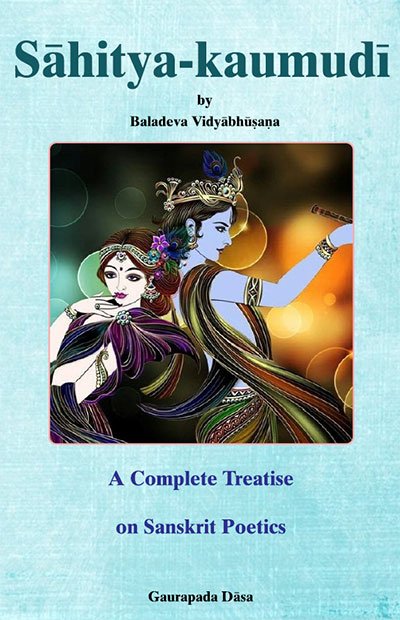Sahitya-kaumudi by Baladeva Vidyabhushana
by Gaurapada Dāsa | 2015 | 234,703 words
Baladeva Vidyabhusana’s Sahitya-kaumudi covers all aspects of poetical theory except the topic of dramaturgy. All the definitions of poetical concepts are taken from Mammata’s Kavya-prakasha, the most authoritative work on Sanskrit poetical rhetoric. Baladeva Vidyabhushana added the eleventh chapter, where he expounds additional ornaments from Visv...
Text 7.86
(2) [This exemplifies kaṣṭa (difficult to understand):]
न वंशी-करम् आसाद्य यमानुजनि-भङ्गतः |
कस्याविशदतां याति मनो मान-परिप्लुतम् ||
na vaṃśī-karam āsādya yamānujani-bhaṅgataḥ |
kasyāviśadatāṃ yāti mano māna-pariplutam[1] ||
na—does not; vaṃśī—of the flute; karam—the sweet sound; āsādya—having obtained (i.e. having heard); yama-anujani—the rules (niyamas, “they arise after yama (restraints)”); bhaṅgataḥ—because of breaking; kasyāḥ—of which girl?; viśadatām—cheerfulness; yāti—attains; manaḥ—mind; māna—because of loving anger; pariplutam—overwhelmed; navam—in such a way that there is novelty; śīkaram—a drop of water; āsādya—after obtaining; yama-anujani—of the Yamunā (“whose birth occurred after Yama’s”); bhaṅgataḥ—on account of the waves; kasya—of which man?; aviśadatām—unclarity; yāti—attains; manaḥ—mind; māna—by false pride; pariplutam—overcome.
Which girl’s mind overwhelmed by a pique would not be in good spirits by breaking all the rules upon hearing the sweet sound of Kṛṣṇa’s flute? (Alaṅkāra-kaustubha 7.55)
Upon getting a thrill from a drop of water thrust from the Yamunā’s waves, whose mind immersed in false pride does not become clear? (Alaṅkāra-kaustubha 7.56)
atra yamānujanir yamunā, pakṣe niyamaḥ, yama-niyamāsana iti gaṇana-kramād iti kaṣṭo’rthaḥ.
Here the word yamānujani means both niyama and Yamunā. The sense of ‘niyama’ is perceived from the sequence of the enumeration in: yama-niyamāsana and so on (Yoga-sūtra 2.29): That meaning is hard to catch.
Commentary:
Kavikarṇapūra gives the same example of kaṣṭa. Still, he and Baladeva Vidyābhūṣaṇa (7.117) specify that kaṣṭa is actually not a fault in citra-kāvya (picture poetry) and the like (yamaka, verses of few consonants, etc.).[2] Kavikarṇapūra shows the two verses as an example of a yamaka of a whole verse: The verse is the same in both interpretations, except that some syllables are connected in a different way. It can also be classed as a śleṣa (literal double meaning).
Footnotes and references:
[1]:
pariplavam (Alaṅkāra-kaustubha).
